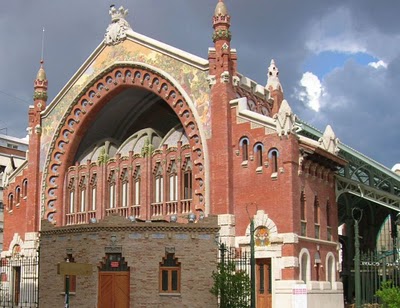
Torres de Serranos
Torres de Serranos were built in order to defend one of the most used entrances to the city of Valencia. There are two polygonal towers flagging the door with a semicircular arc segments.
Each one has three floors and vaulted completely united below by a central body decorated in flamboyant style. In 1397 it was designed the monumental stone staircase, which enlarged the building and facilitating their use in the welcome parties. It is possible to enter the towers to see the beautiful views of Valencia.
Mercado Colon
If you have seen and liked the Central Market there is another market in the city of Valencia which is a must for you to visit, El Mercado Colon (The Columbus Market). This spectacular building is a great example of Valencian modernism from the beginning of the 20th century. It is situated just next to the main shopping area of the city, nearby the underground station “Colon”. You will be there many times for sure so take your time and stray a little to see this impressive place. The building, projected in 1914 by Francisco Mora Berenguer has the surface of 3 500 m2. You can get there a wide range of products of top quality mostly foods, beverages and souvenirs. If you are fan of Gaudi’s style of architecture you will like the market even more since it has noticeable influences of Gaudi.
The Palacio del Marques de Dos Aguas
Palacio del Marques de Dos Aguas is one of the most central places of the city of Valencia. It is a magnificent artistic building, which was noble mansion of the Marques de Dos Aguas, now owned by the Spanish State, which is installed since 1949 as the splendid and valuable National Museum of Ceramics and Sumptuary Arts "Gonzalez Marti". This monumental building, which draws attention of all who contemplate the originality and richness of the artistic decoration of its facades and its splendid interior, was built in the fifteenth century by a family of more ancient lineage of Valencia.
In 1941 the Palace was declared a historic-artistic monument and ,as mentioned above, in 1949 was sold and purchased by the Ministry of Education to locate the important ceramics collection donated to the state on February the 7th , 1947 by D. Manuel González Martíand his wife Doña Amelia Cuñat. For seven years had its headquarters at the home of the founder, but after the restoration of the Palacio de Dos Aguas, conducted between July 26, 1950 and June 18, 1954, opened doors there the National Ceramics Museum.
In the 80’s the Museum needed to improve its infrastructure and facilities and pursue restoration of the building. In 1990 the Museum was closed to the public to undertake the renovation work, which would extend until 1998, when it reopened to the public.
Jardin Botanico
The Botanical Garden of the University of Valencia, also known as Valencias’ Botanical Museum, it was the first botanical garden created in Spain, It has been present in Valencia since the sixteenth century (records are kept of 1567) and It was restored in the years 1987 to 2000. Nowadays the botanical Garden of Valencia is one of the many botanical gems this city has. The botanical garden has about 4500 species belonging to the 5 continents and is administered by the University of Valencia.
Plaza de Toros
The bullring in Valencia is a beautiful monumental building, when looning from outside. It was built in the fifties of the nineteenth century and inaugurated in 1860. It is located in the heart of the city, between the streets Ruzafa and Xativa, a step to the Plaza del Ayuntamiento, and neighbor of the train station.
Albufera
After visiting the numerous monuments, admiring modern architecture, discovering cultural places of the city and hours of shopping you can get a bit tired and need a place to relax. Don’t worry, you don’t need to look too far. Situated just about 10km to the south from Valencia, Albufera Lagoon Natural Park is an idyllic place to recuperate your strength.
You can get there by a special bus that goes there from different points of the city, for example from La Plaza de la Reina. Don’t worry if you haven’t read much of a guide book and have not much information about the place you are about to visit. During the journey that takes about 30 minutes you can listen to the information through earphones in eight different languages.
The park is one of the most valuable treasures to the Valencian people. You can see there the lagoon, the wetlands surrounded by rice fields, different species of birds and fish .The flora and fauna of the area are strictly protected against human activities. You can also take a ride on the boat and see the “barracas”, the nice huts that were traditional in Valencia during many centuries and nowadays are one of the most important assets for Valencian people. All of it gives you the opportunity to meet the nature just outside the busy city. The area, exactly the village of El Palmar is famous for the best authentic Valencian paella and other types of local dishes. There are thirty restaurants, many of which are run by former fishermen so make sure you don’t miss them while you are there.